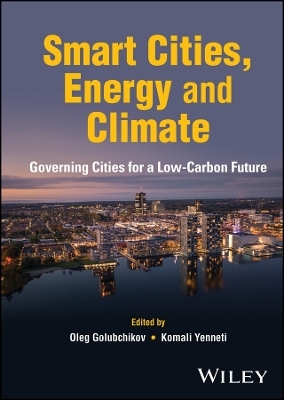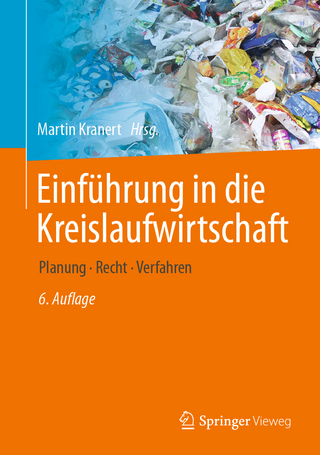
Smart Cities, Energy and Climate
John Wiley & Sons Inc (Verlag)
978-1-118-64066-1 (ISBN)
Smart Cities, Energy and Climate: Governing Cities for a Low-Carbon Future is a seminal work that draws together insights and case studies on post-carbon urbanism across a variety of fields—from smart energy grids to active buildings, sustainable mobility and urban design.
Another objective is to foster an understanding of how digitally-enhanced smart city solutions can assist energy transitions, and what new developments and challenges they bring in areas ranging from urban governance to energy security.
Key topics covered in this book include:
Recent developments in urban planning, building design and smart technologies
Urban-scale digital platforms and innovation for clean energy systems, energy efficiency and net-zero policies
Socio-technical and political relationships in climate-neutral cities and smart cities
Context-rich, situated perspectives from Europe, Africa and Asia
Smart Cities, Energy and Climate serves as a primary reference for scholars, students and policy makers interested in the conceptual, technical, economic and political challenges associated with the transition towards a smart and sustainable urban future.
Prof. Oleg Golubchikov School of Geography and Planning, Cardiff University, Cardiff, United Kingdom. Dr Komali Yenneti School of Architecture and Built Environment, University of Wolverhampton, Wolverhampton, United Kingdom.
About the Editors xiii
List of Contributors xv
1 Introduction: Cities in the Twin Net-Zero and Digital Transition 1
Oleg Golubchikov and Komali Yenneti
1.1 The Rise of Smart Energy Cities 1
1.2 Thematical Threads and Issues 3
1.3 Imagining Smart Urban Energy Systems 6
1.4 Urban Design, Planning and Policies 7
1.5 Technologies and Data for Smart and Low-Carbon Urban Futures 9
1.6 Relevance for Practice and Future Research 11
References 12
Part I Imagining Smart Urban Energy Systems 15
2 Competing Narratives and Interests in Smart Urban Energy Systems 17
Jess Britton and Emily Judson
2.1 Introduction 17
2.2 Smart Energy Cities 19
2.3 Momentum in Energy System Change 20
2.4 Smart Local Energy Systems in the United Kingdom 21
2.5 Competing Logics and Interests 25
2.6 Evolving Smart Energy Governance 26
2.7 Conclusions 29
References 30
3 Where are Smart Sustainable Cities Made? Tracing Wired Socio-Technical Relationships in, Through, Beneath, and Beyond a City 35
Torik Holmes, Rebecca Windemer, and Carla De Laurentis
3.1 Introduction 35
3.2 Orientating Ideas, Approaches and Methods 36
3.3 The City of Manchester 38
3.4 Connecting ‘Smart’ Buildings 40
3.5 ‘Smart’ and Not-So-Smart Large-Scale Network Investments 42
3.6 Turbulent Urban–Rural Relationships and Contingencies 43
3.7 Scout Moor Wind Farm: Policy, Social Attitudes and Limiting Growth 44
3.8 Royd Moor Wind Farm: The Continuation of Ageing Infrastructure 45
3.9 Addressing ‘Hot Areas’ 47
3.10 Conclusions 49
References 50
4 Smart Energy Cities: A Perspective from West Africa 53
Charlotte Ray, Sam Williamson, Zuzana Hrdlicǩová, Derrick Kajjoba, Hillary Kasedde, Lauren Hermanus, Amadu Labor, Joseph Macarthy, and Braima Koroma
4.1 Introduction – Smart Cities: An Urban Panacea? 53
4.2 Smart Energy City in an African Context 56
4.3 Current Policy Environment around Smart Cities and SECs in West Africa 58
4.4 The Need for a More Integrated Approach 63
4.5 Conclusions 65
References 66
5 Beyond Urban Smart Grid Experiments: Replication and Upscaling as Contested Concepts 75
Harald Rohracher, Gudrun Haindlmaier, Klaus Kubeczko, and Dick Magnusson
5.1 Introduction 75
5.2 Analysing Context Conditions for the Replicability of Smart Grid Pilot Projects 77
5.3 Analysis of the Use Cases from the Demo Sites Hartberg and Malmö 81
5.4 Discussion and Conclusions 88
Acknowledgements 90
References 90
6 The Role of Active Buildings in Smart Energy Imaginaries: Implications of Living Well in Low-Carbon Homes and Neighbourhoods 93
Kate O’Sullivan, Fiona Shirani, Nick Pidgeon, and Karen Henwood
6.1 Introduction 93
6.2 Decarbonisation and Smart Energy Systems 95
6.3 Smart Homes, Smart Occupants? 96
6.4 Realising Smart Energy Futures: Active Buildings and Homes 99
6.5 Living Well in Low-Carbon Homes – Initial Insights 100
6.6 Discussion 105
References 106
7 Do Mobility and Sustainability Rhyme in the Autonomous City? 111
Federico Cugurullo and Alexander Gaio
7.1 Introduction 111
7.2 From Smart to Autonomous Cities 112
7.3 Sustainability in the Autonomous City 113
7.4 Autonomous Vehicle-Induced Urbanism 114
7.5 Bicycle Urbanism in the Autonomous City 117
7.6 Conclusions 119
References 120
Part II Urban Design, Planning and Policies 123
8 Re-Defining the Smart City Concept from the Urban Climate Perspectives 125
Joachim Fallmann, Christopher Holst, Matthias Mauder, and Stefan Emeis
8.1 Introduction 125
8.2 Existing Urban Studies 127
8.3 Recent Approaches for Reshaping Building Design 129
8.4 Suggestions for Urban Planning and Building Design 130
8.5 Model Approaches 135
8.6 Conclusion 137
Funding Sources 138
Conflict of Interests 138
References 138
9 Berlin’s Pathway to Climate Neutrality: Scenarios and Measures for a European Metropole 147
Bernd Hirschl
9.1 Introduction 147
9.2 The Search for a Climate Policy Target for Berlin 149
9.3 The Status Quo and Current Trends: Berlin Not Yet on the Path to Climate Neutrality 154
9.4 Scenarios for 2050, 2030 and 2040 – A Restrictions-Based Approach 155
9.5 Strategy Recommendations and Measures for a Climate-Neutral Berlin 160
9.6 Conclusions 162
Acknowledgement 164
Literature/References 164
10 City, Neighbourhood and Citizens: Putting the ‘20-Minute’ Idea to Work in Edinburgh 167
Alice Creasy, Matthew Lane, and Dan van der Horst
10.1 Introduction 167
10.2 The 20-Minute Idea 169
10.3 Case Study: Putting the 20-Minute Concept to Work in Edinburgh 176
10.4 Discussion 185
Acknowledgements 188
References 188
11 From Smart Urbanism to Sustainable Urban Mobility Plan: A Critical Evaluation of the Case of Cagliari 195
Chiara Garau, Giulia Desogus, and Vincenza Torrisi
11.1 Introduction: Sustainable Urban Mobility Plan (SUMP) 195
11.2 Comparison Between the Guidelines for Italian PUMS and the Guidelines of the mcc 197
11.3 Results and Discussion 208
11.4 Conclusions 210
Acknowledgements 210
References 211
12 Analysing India’s Smart Cities Mission from a Sustainability Perspective 215
Sarbeswar Praharaj
12.1 Introduction 215
12.2 Overview of the Smart Cities Mission in India 217
12.3 Untangling the Indian Smart City Models 219
12.4 Sustainability Assessment of Indian Smart Cities 221
12.5 Discussion and Conclusions 231
References 233
13 Energy Transitions and Smart Cities in Russia 237
Irina Ilina and Michinaga Kohno
13.1 Introduction 237
13.2 National Climate Policy 237
13.3 Cities in the Climate and Energy Agendas 241
13.4 The Digitalisation of Energy and Smart Cities 242
13.5 Conclusions 246
References 247
14 Energy Poverty in Cities: A Behaviourally Informed Perspective 249
Nives Della Valle
14.1 Introduction 249
14.2 An Additional Lens to Approaching Urban Energy Poverty 251
14.3 Limitations and Ways Forward 256
14.4 Conclusions 257
Disclaimer 257
References 258
Part III Technologies and Data for Smart and Low-carbon Urban Futures 263
15 Smart Energy Future and Smart Cities 265
Wadim Strielkowski
15.1 Introduction 265
15.2 The Concept of the Smart City 266
15.3 Growing Importance of Cities 266
15.4 Smart Technologies and Energy 268
15.5 Energy Infrastructure for Smart Cities 269
15.6 Concluding Remarks 272
References 273
16 Governing the Transition Towards Smart Grids Through Organised Industry Events 277
Suyash Jolly
16.1 Introduction 277
16.2 Theoretical Background 278
16.3 Research Method 280
16.4 India Smart Grid Week 2016 281
16.5 Discussion: Role of the Event in Facilitating Future Developments 285
16.6 Conclusion 287
References 288
17 Emission Reduction and Renewables Integration Through Distributed Ledger Technology 293
Hamid M. Pouran, Komali Yenneti, Mariana Padilha Campos Lopes, Louis Gyoh, and Yong Sheng
17.1 Introduction 293
17.2 What is the DLT or Blockchain Platform? 293
17.3 How DLT Could Catalyse Mitigation of GHG Emissions and Integration of Renewables 296
17.4 Concluding Remarks 300
References 300
18 Just Comfort: District Heating and Cooling as a Sustainable Energy Solution 305
Keith Baker and Ronald Mould
Glossary of Abbreviations 305
18.1 Introduction – A Brief History of District Heating 305
18.2 Defining District Heating and Cooling by Generation 307
18.3 Technologies and Fuel Supplies 308
18.4 District Cooling 311
18.5 Lessons from Denmark’s District Heating Revolution 313
18.6 District Heating and Cooling as a Solution to Energy Poverty 316
18.7 Defining Successful District Heating and Cooling Schemes 318
18.8 Concluding Remarks 321
References 322
19 The Role of Energy-Efficient Buildings in the Post-Carbon Future 327
Gloria Pignatta and Shayan Naderi
19.1 Introduction 327
19.2 Building Retrofitting 330
19.3 Thermal Mass Energy Storage 332
19.4 Battery Energy Storage 335
19.5 Solar Energy Utilisation 336
19.6 Energy Flexibility in Buildings and Districts 339
19.7 Conclusions 340
References 341
20 Using Bottom-Up Digital Technologies in Technical Decision-Making for Designing a Low-Carbon Built Environment 347
Clarice Bleil de Souza, Camilla Pezzica, and Jakob Hahn
20.1 The Role of Bottom-Up Data in Technical Decision-Making 347
20.2 Possibilities for Bottom-Up Data Gathering 349
20.3 Data Gathered by Sensors on Behalf of the People 351
20.4 Data Gathered by Citizen Scientists Using Digital Technologies 356
20.5 Challenges in Using Bottom-Up Data in Technical Decision-Making 360
Acknowledgements 361
References 361
21 Street Lighting as a Dimension of Smart Energy Cities 365
Mary Thornbush and Oleg Golubchikov
21.1 Introduction 365
21.2 Hardwiring the City 365
21.3 Street Lighting Efficiency 366
21.4 Smart Lighting 367
21.5 System of Street Lights Controller 367
21.6 Connected Security Lighting System 368
21.7 The ‘Smart Pole’ 368
21.8 Dynamic Lighting Control System 369
21.9 Conclusions 370
References 370
Index 373
| Erscheinungsdatum | 27.09.2021 |
|---|---|
| Verlagsort | New York |
| Sprache | englisch |
| Maße | 170 x 244 mm |
| Gewicht | 879 g |
| Themenwelt | Naturwissenschaften ► Biologie ► Ökologie / Naturschutz |
| Naturwissenschaften ► Geowissenschaften ► Geografie / Kartografie | |
| Naturwissenschaften ► Geowissenschaften ► Geologie | |
| Sozialwissenschaften ► Soziologie | |
| Technik ► Bauwesen | |
| ISBN-10 | 1-118-64066-7 / 1118640667 |
| ISBN-13 | 978-1-118-64066-1 / 9781118640661 |
| Zustand | Neuware |
| Informationen gemäß Produktsicherheitsverordnung (GPSR) | |
| Haben Sie eine Frage zum Produkt? |
aus dem Bereich


